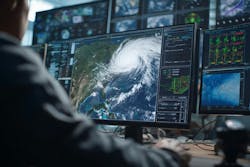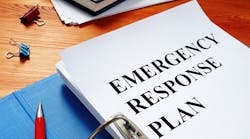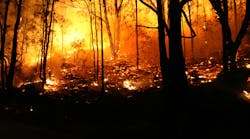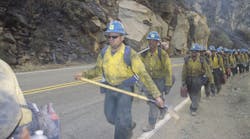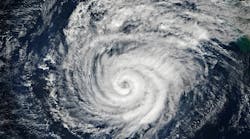Key Highlights
- The weather is always changing. Businesses must balance historical data with current forecast models when developing emergency preparedness plans.
- Any weather condition can quickly turn deadly. That's why it's so important to analyze climate conditions just as you would any other business risk—and have as many contingencies as necessary to keep workers as safe as possible.
- You may not be able to control the weather, but you can control how you react and prepare to weather conditions.
A primary responsibility for meteorologists is to watch for what’s coming next. Typically, we think of this as pertaining to the next storm or heatwave, but this applies to broader changes in weather patterns, too.
EHS Today spoke with Jason Moreland, director of meteorology at AlertMedia, to learn more about the implications of climate change and what safety professionals need to remember with respect to Mother Nature’s potential to cause serious devastation, especially in parts of the world that have not historically experienced certain weather conditions or natural disasters.
It’s worth noting at the outset that all weather can turn deadly, and sometimes weather-related fatalities are not the result of the atmospheric conditions themselves but aftereffects, such as the inability to access life-saving medicines or medical care.
EHS Today: It seems to me that discussions about the weather and natural disasters have changed over the past few years. What have you seen and heard?
Moreland: The general public feels malaise over the constant news of worsening storms and climate change. While there are certainly elements of a changing climate that are contributing, the conversation shouldn’t just be about stronger storms, wildfires and floods. It’s about the increasingly widespread hidden vulnerabilities that compound those events. We’re talking about strained and outdated infrastructure, fragmented warning systems and growing public distrust in government warning systems.
Flood disasters—from Central Texas to Valencia, Spain—show that even when forecasts indicate a potential threat, response gaps and communication failures can turn hazards into tragedies.
Are there any changes or emerging trends in weather patterns that you've observed in the past few years?
Floods and wildfires are intensifying worldwide. In 2025, Canada had its second worst wildfire season on record. In Spain and Portugal, the burned area was five to six times the average. Flooding has killed approximately 1,000 people in Pakistan and hundreds in Nigeria.
These aren’t isolated cases. AlertMedia’s threat intelligence analysts cover localized flood events daily. The impacts are also long-lasting, and communities are dealing with disruptions for months or even years after the water recedes or the fires stop.
What's on your radar now?
Infrastructure strain. Energy grids, water supplies and emergency communication systems are pushed beyond their limits.
Add the rising energy demand from AI data centers, and you’ve got a collision of climate stress and technology growth. We’re already seeing power rationing in Virginia and Texas during heat waves. In Arizona, new data center projects are raising concerns about massive water use during summer droughts and heat waves, which have become increasingly longer in places like Phoenix.
What's something you wish more people understood about the weather and/or natural disasters?
It’s not always the hazard itself that kills; it’s the gaps in how we prepare and respond. In Valencia, a 13-hour delay in local government mobile emergency alerts occurred during a flood that took 200 lives. Several residents didn’t receive the more urgent message until many locations were underwater. This was despite the national weather agency calling for severe rain amounts days in advance.
In [the 2023 wildfires in] Maui, Hawaii, outdoor sirens were never activated. By the time residents realized the fire was spreading, it was too late. Even in 2025, it still largely comes down to better preparedness and multiple means of receiving warning information.
We’re seeing extreme weather and natural disasters occur in parts of the country that haven't historically experienced those conditions. It also seems like those risks are blurring and changing across the country. What do you think folks ought to know?
The threat landscape is certainly changing. Over the last few decades, over 1 million homes have been built in wildfire-vulnerable parts of California. Nationally, over 14 million homes have been added in similar zones. Remote workers are reporting from locations that managers never monitored in the past. Houston, one of the most flood-prone major cities in the U.S., has added 65,000 more properties since the devastation left behind by Hurricane Harvey in 2017.
Do you have any advice for safety professionals who are seeing and experiencing weather conditions that they might never have before, such as heat waves in Portland, Oregon, and wildfires in Alaska?
Don’t assume your past is your future. Combined changes of population, infrastructure and climate make past events—and their impacts—outdated examples. If your region faces hazards you haven’t seen before, look to areas that have and adapt their playbooks now.
Communities in Greece and Turkey, for example, are wrestling with under-resourced firefighting. Rural northern regions of Canada are sometimes evacuated for weeks and months because they lack adequate firefighting resources to contain the blazes. Learning from those lessons early can prevent repeating the same mistakes.
Virtually every weather condition can cause fatalities. At what point does any condition turn deadly, and what do you want folks to remember?
Events turn deadly when systems fail around them. Heat becomes deadly when the power grid goes down, or employers don’t take heed of heat warnings for outdoor workers. Floods become deadly when preemptive evacuations don’t happen in time. Wildfires become deadly when evacuation warnings don’t reach people in time, or residents don’t instinctively react to immediate threats before receiving notifications from authorities.
Sometimes a major event can overwhelm the system, and individuals should be empowered to take appropriate action if they feel like their loved ones are in danger. I want people to remember that weather alone doesn’t create a catastrophe; it’s weather combined with human vulnerabilities.
How can people who work outside stay safe? What else can employers do to protect those workers?
Basics like hydration, shade and shifting work hours matter, but safety professionals also need to prepare for extreme alerts. Employers should have clear protocols for when to stop work for all weather hazards, whether extreme temperatures, damaging winds, flooding or lightning. Protecting outdoor workers is about planning for the unexpected—not just reacting.
Is there anything else that you'd like to add about deadly weather conditions and climate change?
During the recent Central Texas floods, social media was flooded with videos and posts, but not all the information was accurate. TikTok clips, X posts and Facebook updates sometimes questioned the lack of official warnings, pushed conspiracy theories or gave conflicting advice. Similar posts were detected shortly after the January 2025 California wildfires. This kind of misinformation and disinformation can cause hesitation when quick decisions are needed most. To stay safe, it’s important that we trust reliable, official weather sources—not whatever happens to be going viral.
Read more:
About the Author
Nicole Stempak
Nicole Stempak is managing editor of EHS Today and conference content manager of the Safety Leadership Conference.
